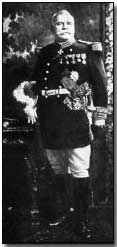Primary Documents - French Government Statement on the Champagne Offensive, September 1915
 Reproduced below is the
official French government statement issued following the commencement of
the resumed French Champagne Offensive in September 1915.
Reproduced below is the
official French government statement issued following the commencement of
the resumed French Champagne Offensive in September 1915.
Regarded as the major Allied undertaking of 1915 the offensive quickly became bogged down in the face of determined German opposition. It was eventually called off for relatively little material advance. Nevertheless the French government made much of those gains that were achieved, as evidenced by the text of the official report below.
Click here to read the official German statement on the offensive. Click here to read German Army Chief of Staff Erich von Falkenhayn's account of the Champagne Offensive.
French Government Statement on the Battle of Champagne, September 1915
During September 26th and 27th we succeeded north of Souain and Perthes in occupying a front facing north and in contact with the German second line along a stretch of seven and a half miles. The ground thus conquered represented an area of some fifteen and a half square miles, and was traversed by lines of trenches graduated to a great depth. The borders of the woods were organized for defence, and innumerable subterranean passages, trenches, and parallels facilitated a resistance foot by foot.
We overcame all these obstacles, imposing our ascendancy on the enemy, and progressing from trench to trench, and on our way seizing batteries, munition depots, and material.
Our soldiers were out to conquer, and the joy of knowing that a powerful German fortress was crumbling in the face of their efforts spurred them forward with greater dash. Our Generals and Colonels took up their posts of command in the shelter of the German officers' huts, and the casemates on which there still hung notices, "Stab Bataillons," "Konzpagnie fuehrer."
The soldiers gaily made a rapid inventory of the dwellings and the rustic canteens installed in the woods.
Our artillery took up positions in the open country, as in the days of war of movement. Our advance progressed with success, for continuing which great honour is due to our troops, in particular the Franc-Comtois and Africains, who had assumed the task of taking a string of wooded hills stretching between Auberive and Souain to the north Roman road.
The Epine de Vedegrange and Hill 150 are the only points which mark this district on the map. It was there that the Germans resisted with much determination in one of their systems of trenches.
Our troops advanced by successive bounds, digging themselves in after each rush, so as to indicate that they had taken possession of the terrain. Thus they succeeded in reaching the enemy's second position at this point, which we have baptized the "parallel of the Epine de Vedegrange." This trench extends eastward unbroken toward Hill 193. Our military vocabulary furnishes many names for it - "Parallel of the wood of Chevron," "Trench of Lubeck." Up to the Navarin farm, further east, it is named "Trench of Kultur," "Trench of Satyrs," and "Trench of Pirates."
On the evening of the 25th we had not attained the second line to the east of Navarin farm. The Germans were holding out in the pine woods which terrace the eastern section of the Souain basin.
The next day our troops, who had gone forward west to a point where the Souain-Tahure road traverses the woods, succeeded in joining hands with those installed on Hill 193. Thus the last defenders of the works in the woods were surrounded. Here we made nearly 2,000 prisoners.
Meanwhile our African troops were gaining ground toward the north, clearing the woods and taking possession of the "Camp of Sadowa," which contained large quantities of material, and the existence of which had already been revealed by our airmen.
Further east we pushed forward our line, installing ourselves on the summit of Hill 201, facing the Butte of Tahure, on which the enemy dug a second line, named "Trench of the Vistula." An attack put us in possession of a little fort at the extremity of the latter.
Along the remainder of the front the pressure was kept up by violent bombardments, by grenade throwing, and by swift attacks. On the "Main de Massiges" ground was thus gained by a sustained action of the colonial infantry. Alternating the fire of the heavy artillery and the field guns with assaults by grenadiers, we succeeded greatly in increasing our gain of September 25th along the northern portion of the promontory.
Germans surrendered in groups, even though not surrounded, so tired were they of the fight, and so depressed by hunger and convinced of our determination to continue our effort to the end.
A German trench stood in the way of our advance. Our artillery concentrated its fire upon it. Toward the end of the afternoon of the 26th, when the observation officer suddenly gave the order to cease fire, he saw the Germans stand up on the crest and put up their hands.
"Seventy-fives! Send a screen of fire behind," ordered the general commanding the division, and immediately the Germans were to be seen running toward our lines, while our colonial infantry went off and installed themselves in the trenches. There they stuck up the pennants with which they had directed our artillery fire and which on the crest torn by shells unfurled themselves like glorious standards.
Source: Source Records of the Great War, Vol. III, ed. Charles F. Horne, National Alumni 1923
'Bantam' was a term to describe members of battalions between 5ft 1in and 5ft 4in.
- Did you know?
